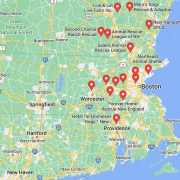
14 Dog Breeds That Use Their Paws A Lot
Alex Vicente • Updated on August 1, 2023
- This review contains affiliate links. Read more here.
- Not a substitute for professional veterinary help.
Dogs are known as man’s best friends.
They have been domesticated for thousands of years, and there’s no doubt that dogs have evolved to start behaving more like humans in certain situations, especially with physical behaviors.
One behavior, in particular, is using their paws like hands, and not just for walking around.
You’re more likely to think of a cat using their paws like hands because of their flexibility to increase and improve their dexterity; however, certain dog breeds are even more likely to use their paws like hands for various situations.
Your dog will definitely be using their paws more than just “shaking paws” to say hello and ask for a treat!
Table of Contents
Boxers
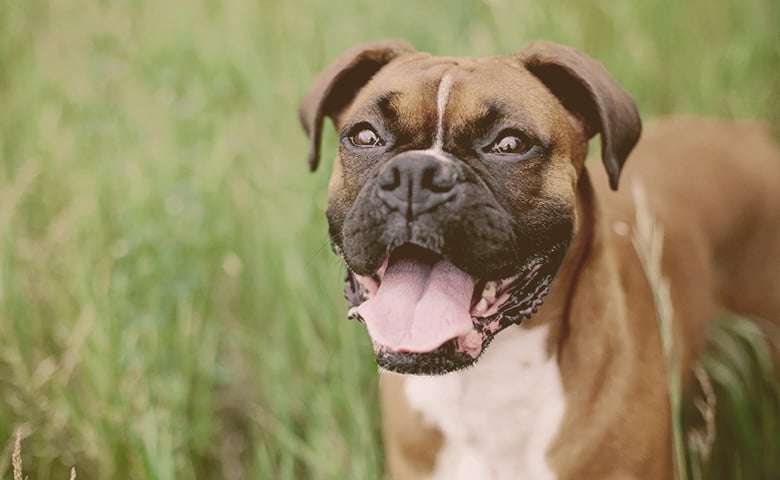
Out of dog breeds that use their paws like hands, boxers are the most well-known dog breed to do this successfully. Even though they’re not really used for boxing, boxers use their paws for communication very frequently. Boxers love giving and getting attention, and their natural personality makes it so common for them to use their paws for communication.
Boxers are also known to stand on their hind legs to play with other dogs with their paws, which does sort of look like boxing. These dogs are also known for how well they are with children and for having an amazing temperament. Boxers will also use their paws to pin down other dogs or humans, show dominance, and play.
Boxers need plenty of space to run around and play. They also love to jump very high. Keep a boxer entertained by playing fetch and training them how to use their paws in different ways.
Beagles
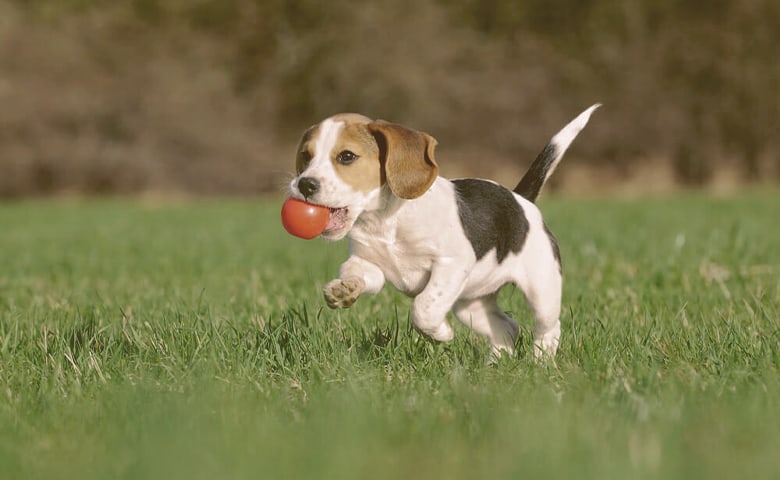
Beagles are loveable animals who were bred for their hunting skills, especially for rabbits and hares. Like many other dog breeds that use their paws, beagles use their paws to point out their prey, kill, and bring their kill back to their owners.
Playing fetch with a beagle is an interesting sight because they are more likely to catch the ball or frisbee with their paws instead of their mouth. They also have a very cat-like behavior where they will clean their face with their paws.
Beagles can sometimes be temperamental, so always ensure you have an outlet for their energy and hunting instinct in your yard and for them to have fun at a local dog park if you don’t have a yard. If you don’t provide an outlet for your beagle, they will quickly become destructive, especially with their paws.
Other resources that you may be interested in:
Australian Shepherds

Australian shepherds have recently gained popularity as household companions. They are known for herding sheep and having a lot of energy. They love using their paws to communicate affection with their owners.
Australian shepherds are one of the most intelligent dog breeds around. They need plenty of intellectual stimulation and space to run around. They will easily get bored and find their own entertainment, which might not be so great for your home or yard.
These dogs are extremely affectionate and can be very needy, thus using their paws to communicate their love and need for attention from their owners. Owners will need to constantly observe their Australian Shepherd’s pawing behavior to prevent incessant pawing while you’re working or trying to do something at home.
Alaskan Malamutes

Alaskan Malamutes are known not only for pulling sleds through the snow and ice but also for their giant size. They used to also aid their owners in hunting prey, using their paws to help with attacking and holding down their prey.
Alaskan Malamutes are highly affectionate and will use their paws to communicate that they want to receive or give attention. Work on training your pup to control their pawing. They may not know their size or strength when it comes to showing affection as well as they do when they’re hunting.
Here’s a video showing just how massive an Alaskan Malamute’s paws and affection are.
You’ll also have to stay on top of your Alaskan Malamute’s grooming, not only with their coat but with the fur between their paw pads as well to prevent debris from getting stuck.
Give your Alaskan Malamute plenty of activities to do around the yard and a place for them to let out all of that energy behind generations of hauling sleds. They will quickly get bored and find anywhere to dig up in your yard or home. They’re also prone to obesity, so don’t just take them for regular walks, put on your running shoes and go for a nice jog with them!
Siberian Huskies

Siberian huskies are known for their distinctive fur and bright blue eyes, as well as their love of playing in the snow. Not only did they play in the snow, but they also used to pull sleds, like Alaskan Malamutes. They are extremely affectionate animals who love to communicate with their owners through kisses and using their paws for hugs and attention.
Huskies are also known to use their paws to play, such as kicking a ball in front of them and asking for attention. While they’re not as big as an Alaskan Malamute, if you don’t keep a Siberian Husky’s paws trimmed, their pawing can really hurt you.
They can also be difficult to house train and become bored easily, so give them plenty of activities to do and do tons of exercise with them. A Siberian Husky’s form of entertainment that they find themselves might not be as entertaining for you to clean up.
Like some other dogs on this list, Siberian Huskies have webbed toes. This was to help them get more surface area as they’re running through the ice and snow. While it’s not so much needed nowadays, let your Siberian Husky out in the snow to play or give them a shallow pool to cool off in on a hot summer day. Even though they have webbed toes, they don’t like to swim.
Terriers

Terriers come in all different types of breeds. Bull Terrier, Rat Terrier, and Scottish Terrier, just to name a few. Across different breeds, terriers are all known to use their paws, especially for communication.
Terriers can be very emotionally needy and will constantly ask for attention and affection. Bull and Rat Terriers are also prone to separation anxiety, so you’ll definitely want to observe their behavior and tame their pawing.
Scottish Terriers will love to tear apart your yard and home if they aren’t given enough mental stimulation, like many other dogs. They love to use their paws for hunting and digging.
Dachshunds

Daschunds, or as most people call them, “weiner dogs,” are hound dogs and were bred to have shorter legs to be able to get into the holes of rabbits and badgers. Since they were bred to have small legs and long bodies, they used their paws to dig and attack their prey.
Since they were bred to be hunting dogs, Dachshunds will use their front paw to communicate that prey is nearby, lifting it in the direction of their prey. This is part of their natural instinct that developed from selective breeding.
You should trim your dachshund’s nails every month and keep them filed down because they can get long and sharp, fast. It is common for Dachshunds to bite their nails, which can lead to an array of acute health problems.
They’re also prone to their paws smelling like Fritos or corn chips. This is due to an overgrowth of healthy yeast on their paws. Wash their paws frequently with dog shampoo and water. Make sure to get in between their toes and dry them well. Moisturize their paws with a paw moisturizer and pamper your Dachshund with a paw massage.
Miniature Schnauzers
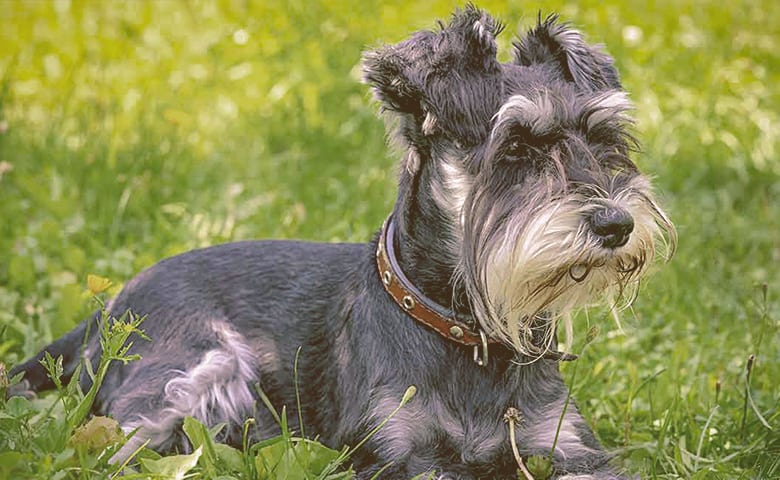
Miniature schnauzers are great companions, especially if you have an apartment or house that is too big for a Schnauzer. Don’t let their size fool you, though. These are very energetic dogs who love to play and run around if you can get them to a dog park.
Miniature schnauzers are very affectionate dogs, so they use their paws incessantly to communicate with you if they’re not already following you everywhere you go. Train them when it is acceptable to use their paws for communication.
Due to the complication of their coats, miniature schnauzers should be groomed by a professional every month, including their nails and paws. Keeping their nails short and filed will prevent them from injuring you unintentionally while they paw at you for attention and to give you their love.
German Shepherds

German shepherds have long been known to aid humans in a variety of situations, especially on the K9 police force! To do this, they use their paws and many other actions, just like humans do, to communicate with their owners strongly. German shepherds have been trained over the years to be bomb and drug-sniffing dogs as well because they have the best sense of smell.
Like most dogs, German Shepherds need to be entertained and have an outlet for their energy. Unlike most dogs, German Shepherds need to have some form of intellectual stimulation due to their intelligence, or else they will dig into anything they can get their paws into, including your couch and carpet.
Provide a German Shepherd with a Kong toy filled with treats, or give them a hunting activity to do in your yard. Routinely run through a series of tricks with your German Shepherd as well to truly build up the bond between you and your pup but also keep them intellectually stimulated.
Labrador Retrievers
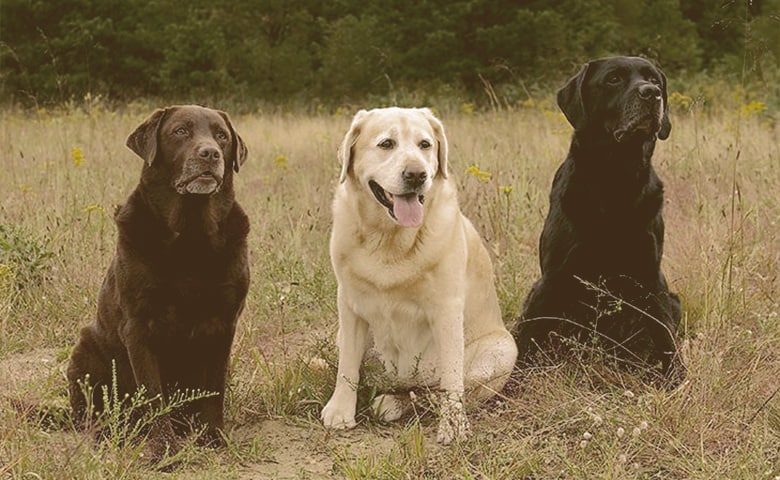
All different retrievers are known for how smart and affectionate they are. Labrador retrievers are known for being service dogs due to their trainability. Service dogs are trained to assist their owners in many ways. They rely heavily on their paws to communicate with their owners and help their owners complete daily tasks. They also love giving high-fives.
Labrador Retrievers also have long, webbed toes to help them swim. Take your lab out for a nice swim at the beach, or let them jump in the pool to hang out and play.
Known for being the more cuddly retriever, golden retrievers also use their paws to communicate with their owners. Golden retrievers are also known for pawing constantly, so they may need a bit more training to control the pawing behavior, or you’re going to want to give them routine nail trimmings. They also can sense sadness and will try to cheer you up!
English Setters

English setters were bred to help their owners for hunting. They will point out their prey, attack, and bring the prey back to their owners. English setters love to play with toys, and if you give them a chew toy, they are very likely to use their paws to hold down the toy while chewing on it.
English setters not only use their paws to communicate with their owners, but they also communicate with other dogs with their paws to play and show affection.
Shiba Inus

Shiba Inus are unique dogs in the sense that they have cat and fox-like behaviors, considering the amount they use their paws to play, eat, and communicate. Shiba Inus are known to use their paws to hold their toys down while playing, open doors, and help them eat. They are also known for their playful and mischievous temperament.
Shiba Inus also like to use their paws to manipulate their surroundings, especially while distracting you from pulling something off your plate or out of your hand.
Akitas

Akitas are known for their fluffy fur, curved tail, and large, muscular bodies. They are also known for using their paws. Playing fetch with an Akita might look a little different from most other dogs because they’ll use their paws to help them catch and retrieve the ball rather than their mouths. Akitas are also known for using their paws to open doors and to turn on faucets to drink.
Akitas are easily trainable, so you can definitely teach them many tricks and tasks to use with their paws. This is because they have cat-like feet, meaning there’s an extra bone to help with their dexterity.
English Pointers

The British bred English pointers to hunt birds. With their breeding, they had used their paws to help attack and hold onto their prey. They also point at their prey with their paws to communicate with their owner that they found something. If you have an English Pointer and don’t go hunting, you will want to adapt your home and yard to help them fulfill their hunting needs.
English Pointers and other hunting dogs will not only point with their paws to direct their owner toward prey, but they will also use their entire body, including their tails, to direct their owners to prey.
Not only are they known for pointing out prey, but they also have a kind, loveable, and affectionate side to use their paws to hug and pet their owners.
Why do Dogs Use Their Paws?

When we think of a dog using their paws, you mostly think of the tricks “shake paw” and “high-five,” which are trained tricks to get them to behave to give them their food or treats. The wonderful world of dogs using their paws is more expansive beyond those simple tricks.
Dogs use their paws for a multitude of reasons. The breeds that are more likely to use their paws have these behaviors mostly through their breeding over generations. Some of the reasons are:
- Communication, whether it’s to show affection, ask for affection, or to warn someone of danger. This action is known as “pawing.” It’s similar to a human tapping the shoulder of someone else. Pawing can also show signs of being ready to play, submission, and apologizing.
- To play, such as kicking and catching a ball or frisbee and playing with other dogs. Dogs also love to use their paws for swimming, and some breeds have a webbed paw to aid with swimming.
- Hunting, especially with actions like digging and finding and killing prey. Some dogs are also experts in fishing.
- Daily tasks as service dogs to help open doors, turning lights on and off, and helping with transferring a person to and from their bed from a wheelchair.
Additionally, dogs have a unique claw on their front paws, called dewclaws. They appear to be like thumbs on humans, but they don’t have the dexterity of thumbs. Rather, dewclaws are used to help dogs get a better grip on prey, bones, and toys. They also play a role in giving dogs traction while they’re running.
Can I Train my Dog to Use Their Paws?
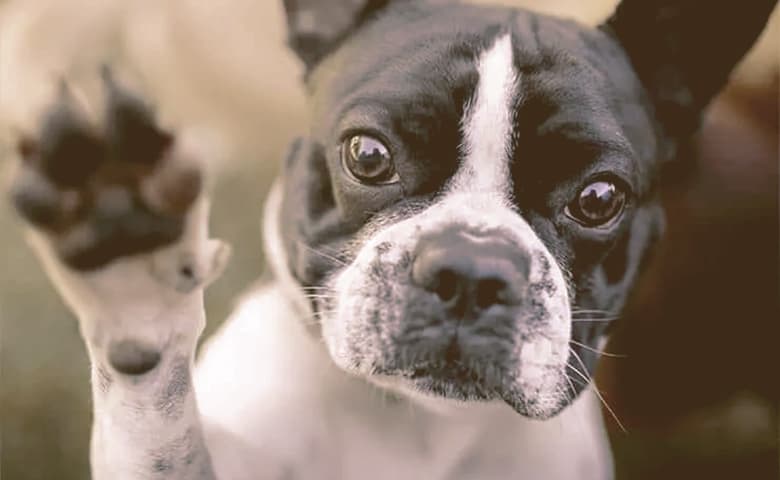
Outside of teaching a dog to “shake paws,” you may be wondering if there’s anything else you can train them to do with their paws. The answer is yes!
The above-listed dog breeds may naturally use their paws more often in certain situations.
If your dog isn’t one of the above dog breeds, don’t fret! You can still train them to use their paws, but it might not be as easy as training a dog that was mentioned earlier to use their paws. They can be trained to use their paws for communication, playing, and hunting. Keep in mind that other dogs weren’t bred to have these characteristics, so it might not be easy.
How to Train Your Dog to Use Their Paws and Redirect
Training your dog to use their paws can be a fairly simple task, especially for communication. Most of it starts with positive reinforcement. This is where if your dog starts using their paw to communicate, you acknowledge them. If you ignore them, the behavior will start to diminish.
One common way dog owners try to train their dogs to use their paws is to discourage them from scratching at the door to go outside. One thing dog owners commonly do is to train them to use a doorbell with their paws, so they don’t ruin the door and door frame. This redirection still allows the dog to use their paws to communicate without the risk of ruining your doors.
One of the easiest tricks to teach your dog is to shake hands. This is a great way to divert your dog’s attention from something that they’re doing badly and can offer an outlet of communication with their paws.
The best way to do this is to start out with a treat in your closed hand and only give your dog the treat if they put their paw in your hand. Once they have mastered this, add a command, and eventually, you’ll only need to give your pup a treat with shaking paws with just the command and a pet or a hug. Here’s a great video showing how to teach your dog to shake paws.
Can Dogs Have a Dominant Paw?
If humans have a dominant hand, can dogs have a dominant paw? Absolutely! Just like humans, dogs are more likely to have their right side be their dominant side. Also, like humans, dogs can be ambidextrous and use both paws equally.
To find out which paw is your dog’s dominant paw, give them an activity to do, such as the Kong Test, where they have to grab food out of a Kong toy. Notice which paw they use to hold down the toy. That will be their dominant paw.
Training Your Dog to Communicate With Their Paws More Gently

As mentioned earlier, some dogs use their paws to communicate with their owners. They may use them to show love and affection or to get their attention to something, such as danger. While smaller dogs may not have as much force behind their pawing, bigger dogs may not naturally acknowledge the strength behind their paws and can leave you with a nice bruise.
If you want your dog to start using their paws more gently, start by not acknowledging when they start pawing aggressively. Stop them by saying “no” strongly and get them to change their behavior, such as sitting. Reinforce the good behavior with a treat. You can also train your dog to wave at you with a bark instead of pawing to get your attention.
Never hit your dog to try to stop a specific behavior. It can cause your dog to become more aggressive and potentially injure you. Be mindful of your dog around small children who aren’t familiar with your dog as well. Your dog could paw them too hard without meaning to and injure the child.
If your dog is a hunting dog, ensure that they always have an outlet for their instinct to hunt. Spend plenty of time playing with them and providing enriching activities like scavenging for treats and toys in the yard. Reward and reinforce when they use their paws versus their mouths to complete a task.
How to Take Care of Your Dog’s Paws

Your dog’s paws are an essential part of their bodies. They use their paws for many different things outside of communicating and completing tasks. It is vital to take care of your dog’s paws properly and routinely; even if you regularly take your dog to your groomer, there are things you should do to prevent injury and in between groomings.
Keep your dog’s nails short, so when they do paw you to communicate, they’re less likely to injure you. You should also use a paw moisturizer on their paws if you notice they’re starting to get dry or cracked. As a dog ages, their paws naturally get harder, so ensure they stay moist and healthy. Only use a dog paw moisturizer since human moisturizers can harm them.
You won’t only need to trim your dog’s nails. You’ll also need to trim the hair in between the pads on their paws. This is important because debris can get stuck in the long fur. If you don’t feel comfortable trimming your dog’s nails or the hair between your paws, you should take them to a groomer to safely groom your pup.
Be careful when letting your dogs out in extreme temperatures. Hot sidewalks can singe their paws. Not only can freezing cold temperatures harm your dog’s paws, but the salt placed on the ground to melt ice can cause chemical burns on your dog’s paws. Make sure to not let them out in areas with salt on the ground or find a good pair of boots to protect their paws.
Wounded Paws
Sometimes it is inevitable that your dog hurts their paw. Even though they use their paws like humans use their hands, dogs rely on using their paws to walk, so they will always be on their paws. If your dog has a small abrasion, you can use a mild cleanser to clean the wound and bandage it. If it is a deeper or bigger wound, take your dog to the vet for proper care.
Dogs also will chew on their paws for various reasons. Some reasons include allergies, infections such as a yeast infection or athlete’s foot, or anxiety. If your dog is chewing on their paws, take them to the vet to help find out the reason why they’re gnawing. They could seriously injure themselves or cause an even worse infection on their paws.
Since dogs may use their paws to communicate to go outside, they can eventually wear away at a wooden door frame, exposing wood splinters. Ensure your door frames are sanded down or protected, and routinely check your dog’s paws for splinters.
You should make it a habit always to inspect your dog’s paws after they come inside for any debris or signs of injury. Make sure to wash and wipe their paws dry to prevent infections (and from getting your floors muddy!).
Conclusion

Through selective breeding, many dog breeds are more likely to use their paws in many human-like ways. Even if your dog isn’t on the list, it doesn’t mean that they can’t be trained to use their paws in most ways. If your dog does use their paws a lot, it is essential to keep their paws cleaned, and their minds entertained to prevent destruction in your home.








